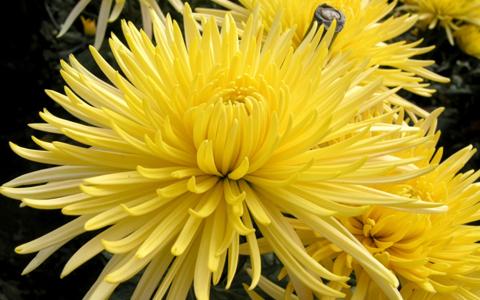
This is the VOA Special English Agriculture Report.
People have grown chrysanthemums for more than 2,000 years. Chinese and other Asian cultures make tea with the flowers. But mums also make bright and colorful gardens.
One basic kind of mum is the hardy or garden mum. The other basic kind is the florist mum. The garden mum is better able to handle different growing conditions than the florist mum.
There are many varieties of mums. The decorative mum is often seen in gardens. Another popular type, the quill mum, has long, straight petals like a tube or needle.
Chrysanthemum blooms can be white, yellow, gold, red or other colors. The plants often grow to one meter in height.
The soil should be kept moist but well drained so it does not get too wet.
Newly planted mums should be watered two or three times a week, depending on conditions. Plants established in the ground may do well with just normal rainfall. In dry conditions they will need more water.
Mums grow best in full sunshine. They produce colorful blooms when days get shorter and nights get longer. The life cycle of the plant depends on the amount of daylight. This is why experts advise against placing mums near nightlights or streetlights. The light may interfere with their normal growth cycle. The plants may develop buds too soon.
In climates where temperatures fall below freezing, plant mums at least six weeks before the first frost is expected. That way, the plants will be well established for cold weather.
Placing mulch around the plants can protect them from the cold. Doug Akers from the cooperative extension service at Purdue University in Indiana suggests straw or shredded leaves for the mulch. The material will also add nutrients to the soil.
Some gardeners say the most beautiful presentation comes from planting mums close together. But they also advise leaving enough space between the plants so air can flow. If not, the chance of disease may increase.
To get more blooms, gardeners pinch back the branches when new growth has extended to 15 centimeters. Squeeze about five to seven centimeters off each branch. Pinch again when a branch grows another 12 to 15 centimeters. Stop pinching about 100 days before you want the plants to bloom.
And that’s the VOA Special English Agriculture Report, written by Jerilyn Watson. You can find all of our reports with transcripts and MP3s at voaspecialenglish.com. I’m Faith Lapidus.
mulch: material, for example, decaying leaves, that you put around a plant to protect its base and its roots, to improve the quality of the soil or to stop weeds growing 覆蓋物,護根(用以保護植物根基、改善土質或防止雜草生長)
World Food Prize honors heads of two groups based in US
In the garden: getting started with roses
Farmers in East Africa struggle against cassava disease
A chicken in every pot: finding new uses for feathers
(來源:VOA 編輯:陳丹妮)
